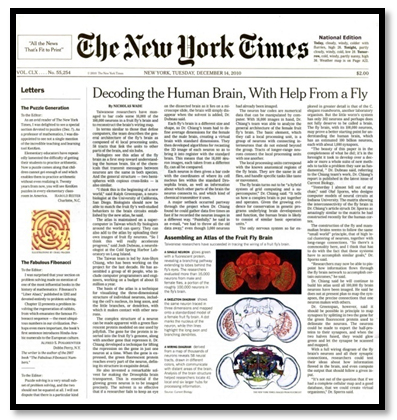News
Decoding the Human Brain, With Help From a Fly
By NICHOLAS WADE Published: December 13, 2010
Taiwanese researchers have managed to bar code some 16,000 of the 100,000 neurons in a fruit fly’s brain and to reconstruct the brain’s wiring map.
In terms similar to those that define computers, the team describes the general architecture of the fly’s brain as composed of 41 local processing units, 58 tracts that link the units to other parts of the brain, and six hubs.
Biologists see this atlas of the fly brain as a first step toward understanding the human brain. Six of the chemicals that transmit messages between neurons are the same in both species. And the general structure — two hemispheres with copious cross-links — is also similar.
“I think this is the beginning of a new world,” said Ralph Greenspan, a neurobiologist at the University of California, San Diego. Biologists should now be able to match the fruit fly’s well-studied behaviors to the brain circuits established by the new atlas, he said.
The atlas is maintained on a supercomputer in Taiwan which fly biologists around the world can query. They can also add to the atlas by uploading their own images of fruit fly neurons. “So I think this will really accelerate progress,” said Josh Dubnau, a neurobiologist at the Cold Spring Harbor Laboratory on Long Island.
The Taiwan team is led by Ann-Shyn Chiang, who has been working on the project for the last decade. He has assembled a group of 40 people, who include computer programmers and engineers, working on a budget of about $1 million a year.
The basis of the atlas is a technique for visualizing the three-dimensional structure of individual neurons, including the cell’s nucleus, its long axon, and the little branches, or dendrites, with which it makes contact with other neurons. more
